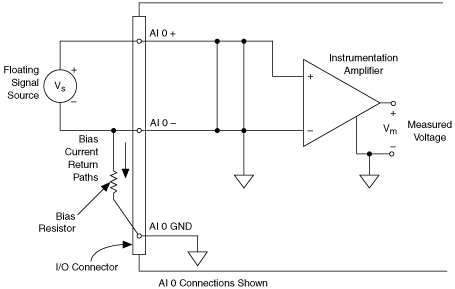Differential Connections for Non-Referenced or Floating Signal Sources
The following figure shows how to connect a floating signal source to a channel.

This figure shows a bias resistor connected between AI 0 − and the floating signal source ground. This resistor provides a return path for the bias current. A value of 10 kΩ to 100 kΩ is usually sufficient. If you do not use the resistor and the source is truly floating, the source is not likely to remain within the common-mode signal range of the instrumentation amplifier, so the instrumentation amplifier saturates, causing erroneous readings. You must reference the source to the respective channel ground.
DC-Coupled, Low Source Impedance
You must reference the source to AI GND. The easiest way to make this reference is to connect the positive side of the signal to the positive input of the instrumentation amplifier and connect the negative side of the signal to AI GND as well as to the negative input of the instrumentation amplifier, without using resistors. This connection works well for DC-coupled sources with low source impedance (less than 100 Ω).
DC-Coupled, High Source Impedance
For larger source impedances, this connection leaves the DIFF signal path significantly off balance. Noise that couples electrostatically onto the positive line does not couple onto the negative line because it is connected to ground. Hence, this noise appears as a DIFF-mode signal instead of a common-mode signal, and the instrumentation amplifier does not reject it. In this case, instead of directly connecting the negative line to AI GND, connect the negative line to AI GND through a resistor that is about 100 times the equivalent source impedance. The resistor puts the signal path nearly in balance, so that about the same amount of noise couples onto both connections, yielding better rejection of electrostatically coupled noise. This configuration does not load down the source (other than the very high input impedance of the instrumentation amplifier).
You can fully balance the signal path by connecting another resistor of the same value between the positive input and AI GND. This fully balanced configuration offers slightly better noise rejection but has the disadvantage of loading the source down with the series combination (sum) of the two resistors. If, for example, the source impedance is 2 kΩ and each of the two resistors is 100 kΩ, the resistors load down the source with 200 kΩ and produce a –1% gain error.
AC-Coupled
Both inputs of the instrumentation amplifier require a DC path to ground in order for the instrumentation amplifier to work. If the source is AC coupled (capacitively coupled), the instrumentation amplifier needs a resistor between the positive input and AI GND. If the source has low-impedance, choose a resistor that is large enough not to significantly load the source but small enough not to produce significant input offset voltage as a result of input bias current (typically 100 kΩ to 1 MΩ). In this case, connect the negative input directly to AI GND. If the source has high output impedance, balance the signal path as previously described using the same value resistor on both the positive and negative inputs; be aware that there is some gain error from loading down the source.

